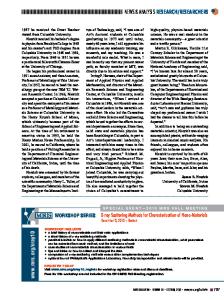In Memoriam: James W. Mayer
- PDF / 284,464 Bytes
- 2 Pages / 585 x 783 pts Page_size
- 25 Downloads / 323 Views
for example, could avoid damaging cells, Kotov said. These electrodes could also be used in displays that can roll up or in the joints of lifelike “soft” robots. Because the chain-forming tendency of nanoparticles is so universal many other materials could stretch, such as
semiconductors. In addition to serving as flexible transistors for computing, elastic semiconductors may extend the lives of lithium-ion batteries. Kotov’s team is exploring various nanoparticle fillers for stretchable electronics, including less expensive metals and semiconductors.
In Memoriam
trical and Electronic Engineers. In 1981, he received the Von Hippel Award, the highest honor bestowed by the Materials Research Society, for having “carried out research on implantation that identified the damage and the epitaxial regrowth phenomena crucial to the semiconductor industry, and pioneered the use of ion beam techniques for materials analysis.” Three years later Jim was elected to the National Academy of Engineering. Among Jim Mayer’s many accomplishments, three stand out as exceptional scientific and technological advances. In the 1950s, he played a critical role in the development of semiconductor detectors to measure the energy of energetic particles and ionizing radiation. Second, he was pivotal in the creation of the field of ion-beam analysis, often referred to as Rutherford backscattering spectrometry (RBS), as a major analytical tool for materials science. He used RBS to define many of the advances in thin-film science of the 1970s and 1980s, including thinfilm reactions and kinetics, solid-phase regrowth of semiconductors, ion-beam mixing for the formation of metastable alloys, implantation disorder and impurity location in semiconductors, and the study of metal silicides and dielectric films. His third major contribution was the development of ion implantation to electrically dope silicon. Using RBS and ion channeling, Jim discovered the key annealing steps to remove implantation disorder and activate implanted dopant atoms, making ion implantation a practical tool. The importance is summed up by the story of the 1970 plenary speech at the first international conference on ion implantation by an electronics industry head who firmly predicted that implantation would never be used in the electronics industry. One year later implantation
was on the production floor of every major semiconductor house, enabling low power complementary metal oxide semiconductor integrated circuits and the myriad of computer and communication applications that followed. As equally amazing as his scientific accomplishments was Jim Mayer’s mentoring and dedication to helping others. He guided more than 40 graduate students. He had a steady stream of visiting scientists from around the world in his laboratory, creating an “extended family” of lifelong friends. Jim had an encyclopedic memory for what was published in the field and would admonish those around him to “never forget your own data.” It has been said that people did their very best work when they
Data Loading...











